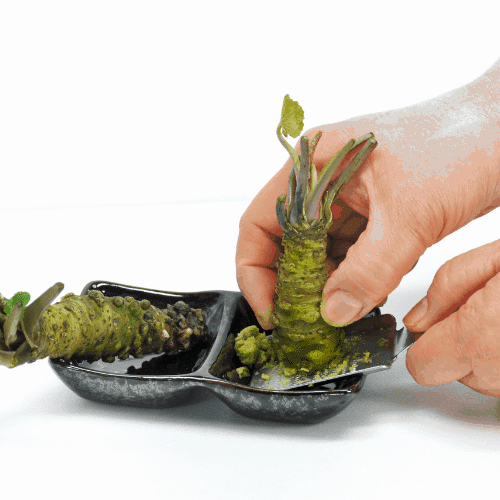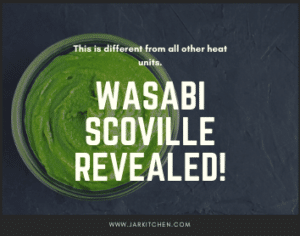Table of Contents
It’s well known that wasabi gives a different kind of burning sensation. People often dare each other to eat it! Right before someone’s first wasabi experience, they most likely have wondered just how hot it is. I remember my first time, I was pretty nervous. And most people probably get nervous about how the burn will make them feel, how long it will last, and what can make it go away (milk?). People usually ask whether it’s more spicy than other peppery foods they know. But it is hard to answer as everyone’s pain threshold differs, plus, wasabi is a root, not a pepper. It would be easier to try it if they knew what the wasabi Scoville heat unit was. The downside is that doesn’t exist, as explained in the following paragraph. Read on to learn more!
Wasabi Scoville Value
Although the pungency of food is relative, Wilbur Scoville, an American pharmacist created a proportionally impersonal system of measurement in 1912, which serves to rank the chili peppers according to their spiciness or heat. However, unlike chili peppers, wasabi which is a root, basically not a pepper. That is why it can not be measured by the Scoville scale. It indicates from the concentration of ‘’capsaicin’’, a molecule that is based on oil; the ingredient of chili peppers that cause the sense of burning on the tissue it directly contacts.
How Spicy is Wasabi Scoville?

Wasabi causes a short-term burning as it is a different type of hot. When compared to chili peppers most of us familiar with, wasabi is different. The smaller chemicals found in the wasabi vaporize and reach to your nose where the burning sensation happens. Additionally, it causes lacrimation. In order to avoid excessive pain, it should be consumed in small proportions. The heat can be diminished simply by water or other liquids as isothiocyanate is water-soluble. Although it is not directly linked, wasabi kind of has a similar effect with the eucalyptus or menthols but stronger and more painful than those two. Alongside its spiciness, wasabi is a very sensitive taste as it tends to lose its flavor very fast. In restaurants, they serve it as freshly prepared and in 15 minutes, the savor fades away.
Why Does Wasabi Burn Differently?

Capsaicin is a compound that attaches to the TRPV1 pain receptors of the tongue. It causes a feeling like there is a fire in your mouth. Just like the pain of eating tremendously heated food. In the case of wasabi, the name of the substance that causes pain is allyl isothiocyanate (AITC). It affects nasal passages for a short amount of time comparing to the length of pain that capsaicin creates.
Some may ask: Why we feel the heat in our nasal passages and not in the tongue? Because the wasabi receptor, which is known as TRPA1 and is a member of the family of receptors called transient receptor potential (TRP), is located in the nasal passages. This is also related to the receptors that help the body identify capsaicin. When some chemical compounds our body is not familiar with bind to the receptor, it stimulates both our nose and eyes which can cause burning, cough, itch. It also responds to stuff like tear gas, cigarette smoke or onion, etc.
If you are wondering what exactly happens when you eat something spicy that contains capsaicin, check out our article on Taco Bell Diablo Sauce Scoville!
Is There Any Chance That Wasabi Would Kill You?
There answer is, it depends. Wasabi has a chemical known as Allyl isothiocyanate in it. It appears that there is a 50% chance of dying from ingesting 9 grams of allyl isothiocyanate, in the case that the person who consumes it is a 130lb adult. But that would mean you’d have to eat A LOT of wasabi: a person would need nearly 20 pounds of the wasabi to kill them. As the maximum capacity of the human stomach is 1.5-2 liters on average, the chances of wasabi killing you because of excessive eating are very low.
Where does it come from?

Wasabi sauce is produced from a plant called Wasabi Japonica which is a member of the Brassicaceae family. This family includes cabbage, mustard, and horseradish, which are also pungent foods. Surprisingly, the paste that restaurants serve by sushi on our plate is usually not actual wasabi, rather a mixture of mustard, starch, horseradish, green food coloring, and other spices. Because wasabi is expensive and is somehow difficult to cultivate. The water quality and proper climate are highly important for this plant to grow. Therefore, we all have probably tasted the ‘’western wasabi’’ instead of the original one. To make wasabi, you will need to find a top rated food processor.
Benefits of Wasabi
If you are a wasabi eater, we have some good news for you! Wasabi is nutrient-rich in terms of vitamins and minerals. As the most famous ones, vitamin C, magnesium, zinc, and potassium are just a few of them. Another and maybe more interesting feature of wasabi is that it contains isothiocyanate which is a strong antioxidant. Wasabi is also helpful to digest better by getting rid of harmful bacterias in the stomach. That’s why scientists to consume it with sushi which contains raw fish that can cause contamination.
Conclusion on Wasabi Scoville
To conclude, wasabi is a unique and expensive flavor that might sound exotic, however, it is a root plant that has similarities with well-known plants like cabbage, horseradish. The thing that evokes curiosity most about wasabi is probably its pungency which makes many people wonder about the wasabi Scoville heat unit. Unfortunately, there is no such measure as the chemical compound of the wasabi is entirely different than of the peppers and as a result, chemical compounds affect the area in the body, which are different in each.
Did you know wasabi is one of the most expensive plants in the world? That’s because it has many health benefits such as healthier digestion, antioxidant function, vitamins, and minerals it contains. But its heat is incomparable to other hot, spicy foods, those we are more familiar with and people use them more worldwide. Finally, a fun fact about wasabi: a Japanese company has invented a wasabi smoke alarm for deaf people! The smell of wasabi is the most effective one among other potential odors to wake people up as it takes less than two minutes.

This is Berk from the JarKitchen Team. I am a Mechatronics Engineer and I like cooking in my spare time. By bringing my engineering background into the business, product reviews are a specialty for me. During my travels across Europe, I have learned/tested many recipes and now I plan to bring them to you here!







